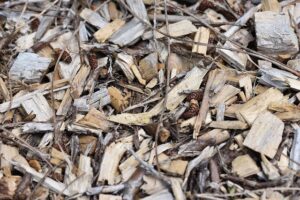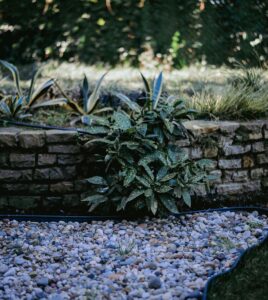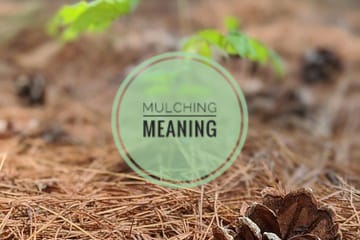If you’ve searched for mulching meaning, you’re likely curious about why gardeners use it. The answer is simple: mulching transforms soil health, saves water, and makes plants thrive.
Have you been wondering why your plants don’t grow as strong, healthy, or beautiful as they should? Chances are, the secret lies in mulching.
If you’re here, you probably want better soil, reduced weeds, or improved plant health. Mulching might be the simple solution you’ve been searching for.

Introduction
Mulching is one of the most effective gardening techniques, yet many beginners don’t fully understand it. In simple words, mulching means covering the soil around plants with protective material.
This material can be organic, like leaves, straw, or compost, or inorganic, like stones, gravel or plastic sheets. Each type of mulch serves a specific purpose.
Mulching may look like a basic practice but it does far more than making gardens neat. It improves soil, saves water, and protects plants from harsh conditions.
In this blog, we’ll learn what mulching is, the many advantages it offers, and how you can apply it step by step.
What is Mulching?
Mulching is the process of applying a protective covering over the soil surface around plants. The main goal is to improve soil and plant health.
It acts as a blanket for your garden soil. Just as we cover ourselves for warmth and protection, soil too benefits from this covering.
Mulching can regulate soil temperature, preserve moisture, reduce weeds, and add nutrients. It’s simple, natural, and highly effective for beginners and experts alike.

Types of Mulch
There are two broad categories of mulch: organic mulch and inorganic mulch. Both have different purposes and benefits.
Organic Mulch
Organic mulch is made from natural, biodegradable materials. Common examples are straw, leaves, compost, bark, grass clippings, sawdust, and coconut husk.
It slowly decomposes over time, enriching soil fertility with nutrients. Organic mulch also encourages earthworms and beneficial soil organisms to thrive.

Inorganic Mulch
Inorganic mulch includes materials like stones, gravel, pebbles, landscape fabric, and plastic sheets. These do not decompose but still provide effective weed and moisture control.
While they don’t enrich soil, inorganic mulches last longer. They are great for pathways, decorative beds, and areas where low maintenance is preferred.

Importance of Mulching
Why do gardeners everywhere talk about mulching? Because it directly impacts plant health and soil quality. Without mulching, soil often suffers from dryness, erosion, or weed invasion.
Mulching provides protection and nutrition to the soil. It also saves time and effort by reducing frequent watering and constant weeding.
Whether you are growing flowers, vegetables, fruit trees, or shrubs, mulching creates a better environment for healthy plant growth.
Advantages of Mulching
Mulching is packed with advantages. Let’s explore them in detail:
1. Moisture Retention
Mulch reduces evaporation, keeping soil moist for longer. This means plants require less frequent watering, especially during hot summer months.
2. Temperature Control
Mulch acts as insulation. It keeps soil cool in summer and warm in winter, protecting roots from extreme weather.
3. Weed Suppression
By blocking sunlight, mulch prevents weed seeds from sprouting. This reduces competition for nutrients and water, helping plants thrive.
4. Soil Enrichment
Organic mulch decomposes gradually, adding nutrients back into the soil. This improves fertility, structure, and overall soil health naturally.
5. Preventing Soil Erosion
Mulch protects topsoil from wind and rain. It prevents valuable nutrients from washing away during heavy downpours.
6. Disease Reduction
By creating a barrier, mulch reduces soil-borne diseases from splashing onto leaves, especially in vegetable plants like tomatoes.
7. Aesthetic Appeal
Mulching makes gardens look neat and professional. Decorative mulches like bark chips and stones enhance overall landscaping beauty.
8. Encouraging Soil Life
Worms and microbes love organic mulch. These tiny workers break down matter, aerate soil, and support natural growth.
9. Saving Time and Effort
Mulching reduces the need for constant watering and weeding. This makes gardening less tiring and more enjoyable.

Procedure of Mulching
Applying mulch is simple but requires a few careful steps. Here is a clear procedure to follow:
Step 1: Prepare the Soil
Start by removing weeds, debris, and rocks from the soil surface. Loosen the soil lightly with a rake for better coverage.
Step 2: Choose the Right Mulch
Select mulch based on your garden’s needs. Organic mulch is best for enriching soil. Inorganic mulch works well for long-term coverage.
Step 3: Apply the Mulch Layer
Spread mulch evenly around plants, leaving some space near the stem or trunk. This prevents rot and allows airflow around roots.
Step 4: Maintain Proper Thickness
Keep mulch about 5–8 cm thick for most plants. Too thin won’t help, and too thick may suffocate roots.
Step 5: Replace and Refresh
Organic mulch decomposes over time, so replace or top it up regularly. Inorganic mulch may need rearranging after rains or winds.
By following these simple steps, mulching becomes a routine that greatly benefits your plants.
Best Mulching Materials for Beginners
If you are just starting, here are some easy and effective mulch materials to try:
- Grass Clippings – Readily available, good for vegetables and lawns.
- Dry Leaves – Cost-free, enrich soil with nutrients when decomposed.
- Coconut Husk/Coir – Excellent for water retention in hot climates.
- Straw or Hay – Great for vegetable beds, keeps fruits clean and weed-free.
- Bark or Wood Chips – Attractive, long-lasting, suitable for flower beds.
Each material has its advantages, so choose what fits your garden goals best.
When Should You Mulch?
The best time for mulching depends on your climate and plants.
- Spring – Apply mulch after soil warms to lock in moisture.
- Summer – Mulching protects roots from extreme heat and dryness.
- Autumn – Spread mulch to prepare soil for winter frost.
- Winter – In cold regions, mulch shields plants from freezing temperatures.
Avoid mulching too early in spring as it may trap cold moisture and slow growth.
Common Mistakes to Avoid
Beginners sometimes make errors with mulching. Here are key mistakes to avoid:
- Piling mulch against tree trunks, which causes rot.
- Using mulch layers too thick, suffocating plant roots.
- Forgetting to weed before mulching, which traps weeds underneath.
- Applying fresh grass clippings too thick, causing heat buildup.
- Not refreshing organic mulch regularly as it decomposes.
Learning from these mistakes helps you use mulch correctly and effectively.
Mulching in Different Garden Settings
Mulching works differently for different gardens. Let’s see how it applies:
Vegetable Gardens
Mulch keeps soil moist and prevents diseases. Straw and compost are excellent choices here.
Flower Beds
Decorative mulches like bark chips add beauty while retaining soil moisture.
Fruit Trees
Mulch around trees helps roots stay cool, conserves water, and prevents weeds.
Container Gardens
Use coconut husk or small pebbles as mulch for potted plants to reduce frequent watering.
Lawns and Paths
Grass clippings work best on lawns, while gravel or stones suit walkways.
Eco-Friendly Aspects of Mulching
Mulching is not only good for your garden but also for the environment. By recycling organic waste like leaves or clippings, we reduce landfill waste and improve soil naturally.
It also helps conserve water by reducing the need for frequent irrigation. In this way, mulching supports sustainable gardening practices.
Final Tips for Beginners
If you’re new to mulching, start small. Try covering just one vegetable bed or a few pots. Watch how plants respond.
Don’t overcomplicate the process. Even simple dried leaves or grass clippings can do wonders for your plants.
As you gain experience, experiment with different mulch types to see which suits your garden best.
Conclusion
Mulching may seem like a simple act of covering soil, but its benefits are powerful. It saves water, controls weeds, improves soil health, and makes gardens beautiful.
By learning the right procedure and materials, you can make mulching an easy, rewarding habit in your gardening routine.
If you want a garden that is healthy, productive, and attractive, mulching is a practice you cannot ignore.
Thanks for reading. Keep growing, keep exploring, and don’t forget to return here at gardeningbud.com for more plants, tips and gardening wisdom.
